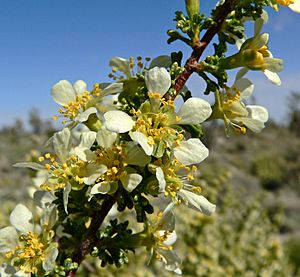Antelope bitterbrush facts for kids
Quick facts for kids Antelope bitterbrush |
|
|---|---|
 |
|
| Conservation status | |
| Scientific classification | |
| Genus: |
Purshia
|
| Species: |
glandulosa
|
Purshia glandulosa is a type of flowering plant in the rose family. It is often called antelope bitterbrush, desert bitterbrush, or Mojave antelope brush.
Where it Grows
This plant grows only in the southwestern United States. This means it is endemic to that area. You can find it in California, Arizona, southern Nevada, and Utah. It lives in places like the Great Basin region and the Mojave Desert. It also grows where chaparral and sagebrush scrub areas meet. These spots are in the Eastern Sierra Nevada, Tehachapi Mountains, and other mountain ranges. You might also see it in pinyon-juniper forests or Joshua tree woodlands.
This plant came from a mix of two other plants. It is a hybrid of Purshia stansburiana and Purshia tridentata. Sometimes, people think it is just a type of Purshia tridentata. It can also mix with its parent plants.
Purshia glandulosa can grow in many kinds of soil. It prefers soil that drains water well. It can even grow in rocky places with little soil. This plant is a pioneer species. This means it is one of the first plants to grow in areas where rock has worn away. It does not like a lot of water, especially in summer. It grows best where about 10 inches (25 cm) of rain falls each year. This plant can handle fire well. It can regrow easily after its top parts burn. Different types of this plant grow from about 1,640 feet (500 meters) to 11,480 feet (3,500 meters) high.
What it Looks Like
Purshia glandulosa is an evergreen shrub. This means it stays green all year. It can grow up to 15 feet (4.5 meters) tall. But it often stays smaller, depending on where it grows. It has a deep taproot that can go almost 16 feet (5 meters) into the ground. This deep root helps it survive when there is little water. Sometimes, this plant has small bumps on its roots. These bumps help it take nitrogen from the air and put it into the soil.
Its flowers are white. They can bloom from February through June. The exact time depends on the specific type of plant.
This plant can make new plants in a few ways. It can grow from seeds. It can also grow by layering, where a branch touches the ground and grows roots. It can also regrow from its root crown after being cut or burned. Even small pieces of root buried deep can grow into new plants. Growing from seeds is not very common. This is because not many seeds sprout. Also, young plants from seeds often do not survive. The seeds have a very hard coat. They grow better if they are stratified. This means they need a cold, moist period before sprouting. Also, the plant does not make seeds until it is about 10 years old.
Different Types
There are different varieties of this plant:
- Purshia tridentata var. glandulosa — This type grows from California to Nevada, Utah, Arizona, and northwestern Mexico.
- Purshia tridentata var. tridentata — This type grows from California up to British Columbia, Montana, and New Mexico.
How People and Animals Use It
The Navajo, Klamath, Paiute, Shoshoni, and other Native American tribes used this plant. They used it as a traditional medicinal plant for different purposes.
The plant is also good food for wild animals like pronghorn. Farm animals like livestock also eat it. Since it is evergreen, its leaves are available for animals to eat even in winter.
See also
 In Spanish: Purshia glandulosa para niños
In Spanish: Purshia glandulosa para niños


